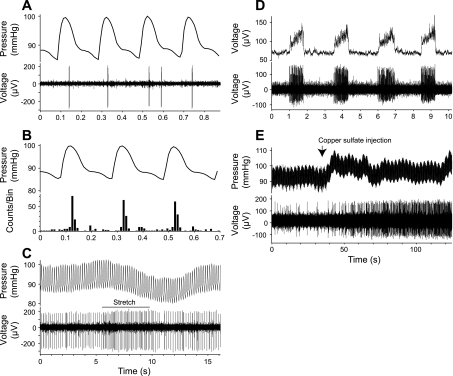Fig. 1.
Examples of different unit types, including cardiovascular units (A–C), a respiratory unit (D), and a GI unit (E). A: data traces showing arterial blood pressure (top) and nucleus tractus solitarius (NTS) unit activity (bottom). These data are from a portion of the run used to generate the averages in B. B: averaged changes in arterial blood pressure (top) and a poststimulus histogram showing associated changes in the NTS unit firing (bottom); 73 sweeps were pooled to generate traces. Averaging was triggered by maximal systolic blood pressure at the central peak. The unit tended to fire just after maximal systolic blood pressure. C: effect of mechanical stretch of the carotid sinus (indicated by horizontal line) on arterial blood pressure (top) and NTS unit activity (bottom). Carotid stretch resulted in a decrease in blood pressure and an increase in the unit's firing rate. D: comparison of phrenic nerve activity (top) to NTS unit activity (bottom). This unit fired during phrenic nerve discharges and was classified as an inspiratory neuron. E: effect of intragastric copper sulfate administration (indicated by arrow) on arterial blood pressure (top) and NTS neuronal activity (bottom). Injecting copper sulfate resulted in a transient increase in blood pressure and a sustained increase in unit firing.

